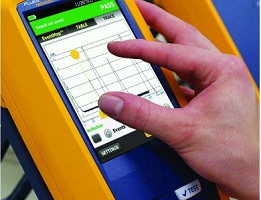
The proper selection and use of network test equipment can substantially reduce the unknown factors of the practice of “plug and pray.” Many technicians often follow the bad habit of terminating network category cable connectivity by plugging in the cable connector and then praying that all communications will work correctly. This practice is wrongheaded on so many levels. First, it has been proven over the years that the biggest problematic technical area of cabling is faulty termination. This is not only true for current network digital connectivity, but has always been a major issue with all other low-voltage cabling technologies as well
Second, digital communications, while being somewhat tolerant to outside noise and electrical influences, can quickly reach that digital cliff when proper communications is lost.
To make things worse this can often be annoyingly intermittent in performance. The following is an overview of some basic but no less important testing parameters for a network cabling circuit.
Crosstalk: A signal on one cable or circuit creates an undesired effect on another circuit or cable. Intermittent crosstalk is a big problem and often caused by poor connector termination.
Delay Skew: This is the difference between propagation delay on the fastest and slowest pairs in a UTP cable. More influential in higher Gigabit Ethernets.
Resistance: This is DC loop resistance between pairs and within cable pairs. Becoming more important now with PoE being used up to 60W for powering connected devices
Wire Mapping: Testing to make sure cables are connected and identified/labeled properly. This can be done by sending and then searching for identifying tones on the cabling with use of end-line identifier devices. Problems found can be cables that are open, shorted, reversed, crossed and split pairs.
TDR/OTDR: The time domain reflectometer test is used to verify distance to cable opens and shorts. It sends tones down the cabling to estimate fault locations. An optical time domain reflectometer is similarly used for testing fiber-optic cabling.











